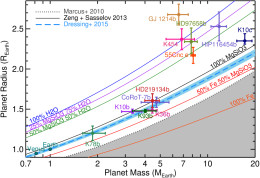Small exoplanets tend to fall into two categories: the smallest ones are predominantly rocky, like Earth, and the larger ones have a lower-density, more gaseous composition, similar to Neptune. The planet Kepler-454b was initially estimated to fall between these two groups in radius. So what is its composition?
Small-Planet Dichotomy
Though Kepler has detected thousands of planet candidates with radii between 1 and 2.7 Earth radii, we have only obtained precise mass measurements for 12 of these planets.

Mass-radius diagram (click for a closer look!) for planets with radius <2.7 Earth radii and well-measured masses. The six smallest planets (and Venus and Earth) fall along a single mass-radius curve of Earth-like composition. The six larger planets (including Kepler-454b) have lower-density compositions. [Gettel et al. 2016]
The planet Kepler-454b, discovered transiting a Sun-like star, was initially estimated to have a radius of 1.86 Earth radii — placing it in between these two categories. A team of astronomers led by Sara Gettel (Harvard-Smithsonian Center for Astrophysics) have since followed up on the initial Kepler detection, hoping to determine the planet’s composition.
Low-Density Outcome
Gettel and collaborators obtained 63 observations of the host star’s radial velocity with the HARPS-N spectrograph on the Telescopio Nazionale Galileo, and another 36 observations with the HIRES spectrograph at Keck Observatory. These observations allowed them to do several things:
- Obtain a more accurate radius estimate for Kepler-454b: 2.37 Earth radii.
- Measure the planet’s mass: roughly 6.8 Earth masses.
- Discover — surprise! — two other, non-transiting companions in the system: Kepler-454c, a planet with a minimum mass of ~4.5 Jupiter masses on a 524-day orbit, and Kepler-454d, a more distant (>10-year orbit) brown dwarf or low-mass star.
Kepler-454b’s newly measured size and mass place it firmly in the category of non-rocky, larger, less dense planets (the authors calculate a density of ~2.76 g/cm3, or roughly half that of Earth). This seems to reinforce the idea that rocky planets don’t grow larger than ~1.6 Earth radii, and planets with mass greater than about 6 Earth masses are typically low-density and/or swathed in an envelope of gas.
The authors point out that future observing missions like NASA TESS (launching in 2017) will provide more targets that can be followed up to obtain mass measurements, allowing us to determine if this trend in mass and radius holds up in a larger sample.
Citation
Sara Gettel et al 2016 ApJ 816 95. doi:10.3847/0004-637X/816/2/95

1 Comment
Pingback: superearths: rocky or gaseous? new findings